This horsey fantasy is clever, funny, irreverent - and also utterly bonkers
By Chantal Nguyen, Penry Buckley, Frances Howe, Peter McCallum and Harriet Cunningham
All the Fraudulent Horse Girls
Old Fitz Theatre
September 1
Until September 14
Reviewed by Harriet Cunningham
★★★½
All the Fraudulent Horse Girls is utterly bonkers. Michael Louis Kennedy’s play, which has already had productions at the Melbourne and Edinburgh Fringe, has finally made it to Sydney, where it continues its bounce from schoolyard politics to Equus-adjacent fantasy to cause-related overshare. It’s anarchic, but it’s also clever, funny, irreverent and occasionally insightful, especially if you are, ever have been, or have ever crossed paths with a horse girl.
Audrey is an 11-year-old girl with a life-defining crush on horses. She doesn’t have a horse, but she does have the pencil case, the backpack, all the books and all the feelings. Sadly, being a horse girl hasn’t helped her make friends at school, but she makes up for her loneliness by summoning up a telepathic connection with horse girls around the world who share her passion.
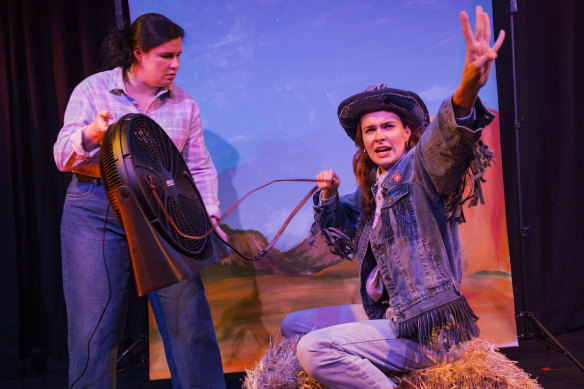
Caitlin Amelia Kearney and Janet Anderson play various incarnations of Audrey.Credit: Robert Catto
Audrey is played by three actors, Shirong Wu, Janet Anderson and Caitlin Amelia Kearney, who also play an assortment of characters ranging from mounted policewomen to Mexican bandits to Carole from Saddle Club (IFKYK).
Wu is terrific as schoolgirl Audrey, marooned on the boundary of childhood and teenager-dom. When Wu’s Audrey is rendered unconscious by a horse kick to the head, Anderson emerges as the next Audrey, a long-legged cowboy riding her straw bale across the desert. When she too passes out, Kearney brings it home as Audrey in the ice-cream van.
If that sounds incoherent, that’s because it is, and proudly so. Wu, Anderson and Kearney are compelling co-conspirators who manage to take their performances tantalisingly close to silliness then, just as you’re about to lose patience, step back from the edge. Meanwhile, we inhabit the torrid world of Audrey’s imagination with ingenious use of props, lights, visual gags and funny walks. The actors even break into melodious three-part harmony, with the help of a little reverb.
In many ways Horse Girls feels like a homage Yve Blake’s FANGIRLS, but where FANGIRLS ties up the threads at the end, Horse Girls embraces chaos, veering off into a whole other reality. It’s confusing and disconcerting and messy and dangerous and perhaps that’s the point. We are all Audrey, whether we love horses or boy bands or frontier fiction or theatre. We all have feelings and we all have to work out what to do with them.
Sunset Boulevard
Sydney Opera House Joan Sutherland Theatre, August 31
Until November 1
Reviewed by CHANTAL NGUYEN
★★★
Luring the world’s best-selling soprano, Sarah Brightman, from a three-decade musical theatre hiatus was a feat of big-name casting for Opera Australia. But her performance in Sunset Boulevard is now a hydra for the already-troubled company, with its Melbourne run haunted by poor reviews, unsold seats and long absences from the stage due to injury.
Brightman needs no introduction. She is the iconic Andrew Lloyd Webber muse (and, for a time, his wife), immortalised in the role she inspired and originated: the beguiling ingenue Christine in The Phantom of the Opera. All big eyes, big hair (it was the ’80s, after all) and a sweet soprano trill, Brightman describes Christine and Phantom as “art imitating life”.
Brightman’s star rose, and she soon left stage shows for a chart-topping recording career. Her voice, with its uncomplicated sweetness, was perfect for both Lloyd Webber’s style and the technical limits of the recording studio.
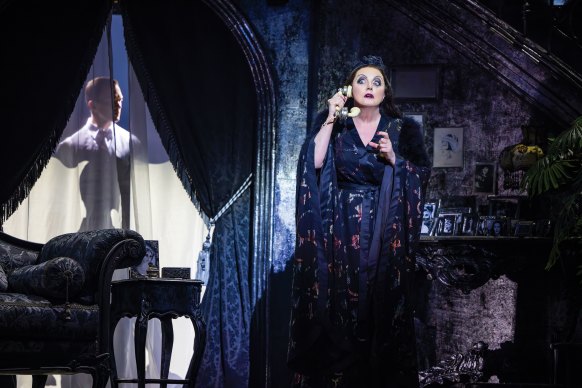
Sarah Brightman is extraordinarily successful at being Sarah Brightman.Credit: Daniel Boud
But this Sunset Boulevard finally confirms what I’ve long suspected: that Sarah Brightman is spectacularly, extraordinarily successful at being Sarah Brightman … but stray too far from that and the signal starts to get shaky.
Unfortunately, the Brightman-Christine persona is light years apart from unhinged Hollywood has-been Norma Desmond, the grotesque, manipulative and ultimately pitiable star of Sunset Boulevard. There’s a fierce magnetism in Norma’s character and songs, which are best sung with a tormented, complex vocal belt. Powerful actresses capable of danger and madness, like Glenn Close, Nicole Scherzinger and Patti LuPone (the original Norma), all sizzled in the role.
Brightman doesn’t sizzle so much as sweetly simper. There’s little difference in her acting when Norma is happy, suicidal, sane, mad, loving or murderous. Brightman’s “arrested development” interpretation – that Norma is developmentally stuck in being an ingenue – is simply unsuited to carrying the vocal or theatrical weight of this tragic role.
Her voice retains its recognisable Brightman sound. Other commentators question her current singing ability, but in my view the decades have simply made more obvious what she always had: a very sweet voice with less tonal complexity, and a wide vibrato now more audible without youth’s sheen. She sings Norma’s line “Let me kiss his severed head … he fought to his last breath” stylistically like Christine’s “Wishing you were somehow here again”. If you ever, in your wildest dreams, asked what it might be like to see Christine in Norma Desmond’s body, this is it.
Apart from Brightman, the other elements of Sunset Boulevard are solid. Veteran performer Tim Draxl is outstandingly charismatic as jaded scriptwriter (and Norma’s victim) Joe Gillis, with smoothly shining vocals and a confident, cynical stage presence. Ashleigh Rubenach radiates charm as Joe’s love interest, Betty Schaefer. The ensemble is polished and unusually age-diverse, and there are top-notch 1950s costumes and a brooding Palazzo mansion from designer Morgan Large.
Showbiz has always used big names over substance to sell seats. Brightman fans will adore this production. Those unfamiliar with Sunset Boulevard might also enjoy it. For my part, I think I might stick to Phantom.
Handel’s House
Yukie Sato, Australian Brandenburg Orchestra
City Recital Hall. August 30
Reviewed by PETER McCALLUM
★★★★ (soloist) ★★★ (concertos)
Japanese soprano, Yukie Sato began her first Handel aria with a lonely distant note of rounded purity, that insinuated itself into one’s consciousness as though it was there before you became aware of it.
Against a hushed but dragging beat from the Australian Brandenburg Orchestra, under Artistic Director Paul Dyer, she sustained the long vocal lines of this number (from Handel’s early allegorical oratorio, The Triumph of Time and Disillusionment) with subtle control of vocal timbre, singing high notes with veiled tone and lips scarcely parted, while allowing lower ones a more open sound as she moved towards the cadence.
If her demeanour here was of stylised poise and strangeness, her second aria, Ah! Ruggiero crudel!, from Handel’s Alcina had drama and full-bodied colour. In this number’s agile passage-work, Sato’s articulation was even and well-placed, a point carefully imitated by the orchestral violins under concertmaster Shaun Lee-Chen.
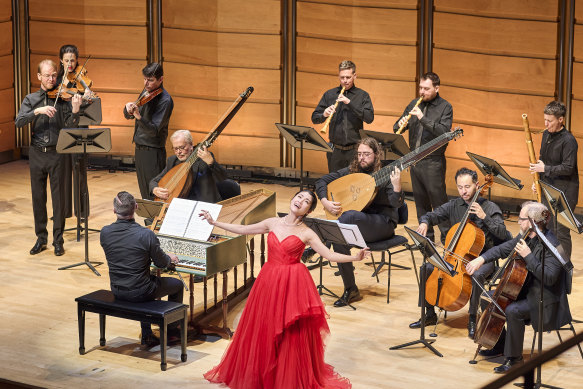
In the carefully shaped, quiet lines of an aria from Handel’s Atalanta, Sato created expressive nuance with gentle, exacting care.Credit: Keith Saunders
She closed the first half with Dopo notte from Handel’s Ariodonte, bursting in with light agility, the rapid streams of notes flowing with blithe grace which belied their difficulty. To start, the Brandenburg Orchestra played the Overture to Handel’s Rinaldo, with neat fast passages from solo violin and solo oboe. Between the arias, Lee-Chen played concerto movements by Pisandel and Vivaldi, the former not without its intonation challenges, the latter quietly expressive against plucked strings.
The second half repeated the same pattern of arias by Handel interspersed with concertos by his contemporaries. In L’amor ed il desin from Handel’s Partinope, Sato moved to unapologetic virtuosity, the rapid passage-work remaining polished, discreet and immaculate even at its most brilliant.
In the carefully shaped, quiet lines of an aria from Handel’s Atalanta, she created expressive nuance with gentle, exacting care, varying the rhetorical tone in the middle section to produce the evening’s most telling musical moments. Her final number, Tornami a vagheggiar from Alcina, was acrobatic and agile, and the personality that had begun the evening with icy remoteness, opened out playfully.
The instrumental numbers included two movements of a concerto by Pisendel, which retained its spirit even when pitch become rough, and a robustly toned Concerto for diverse instruments by Vivaldi that featured gravelly grain from two natural horns, laced with the fine astringency of a pair of Baroque oboes, polished bassoon and fiery violin virtuosity.
MAUI
Sydney Opera House Drama Theatre, August 29
Until August 31
Reviewed by CHANTAL NGUYEN
★★★★
Sydney is enjoying a run of Maori and Pacific dance. Following Bangarra Dance Theatre’s first-of-its-kind collaboration with Maori choreographer Moss Te Ururangi Patterson, the Sydney Opera House presented MAUI, created by Hadleigh Pouesi and Christopher Ofanoa for Aotearoa New Zealand’s Fresh Movement Collective.
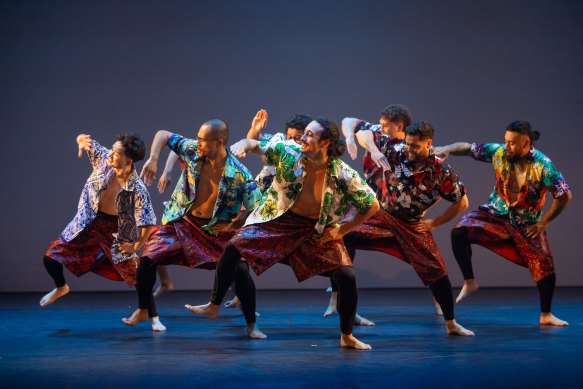
MĀUI is like a fun-street dance variety show.Credit: Daniel Boud
If Patterson’s work was Maori fine arts, MAUI is more like a fun street-dance variety show. It starts with a show-before-the-show: three guys and a guitar, crooning fabulously harmonised feel-good ballads. Cheers erupt for a Pacific cover of Extreme’s More Than Words.
Pouesi describes it as “[encouraging] the audience to sing along … so then when we come in to start the show, we’re starting hot … like you’re going to a State of Origin game”.
MAUI lifts off with all 30 performers belting a Fijian chant, breaking like a wall of sound. Dance and song scenes follow, telling the legends of Pacific demi-god Maui (who inspired the Maui character in the Disney movie Moana), like being given to the sea at birth, and stealing fire from the underworld. They also focus on aspects of his persona, headed by screen-projection titles such as “LOVED” and “RESILIENT” just so you’re in no doubt. These, a friendly Kiwi voice-over tells us, are also the life-giving values of the Pacific peoples. The energy builds to a spoken-word poem and hip-hop number acting as a rallying cry to remember kinship and forgotten warrior strength.
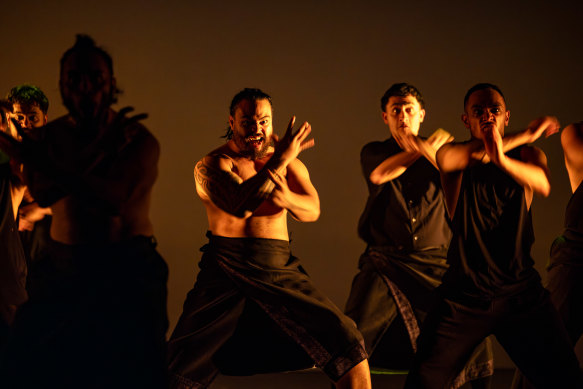
The connection to ancient cultural values endows the variety show format with depth and substance.Credit: Daniel Boud
MAUI is multidisciplinary, combining First Nations dance like the haka, and chants, with street dance – where Fresh Movement Collective really shines. Excepting some stilted, slow modern dance, the movement is sharply well-rehearsed, synchronised and infectiously high-energy. There’s even a Raygun in-joke.
That raw, loveable earnestness and big heart is MAUI’s great strength. The all-important connection to ancient cultural values also endows the variety-show format with a depth and substance often missing in modern dance. Its combination with street dance feels like a raw, real expression of what it is to be young and Indigenous.
Song-and-dance variety shows celebrating migration and national identity often touch a deep chord. Examples include Ireland’s wildly popular Riverdance and – seared into the long-term memory of Vietnamese kids like me – the Vietnamese diaspora’s Paris by Night. The hoity-toity might sniff, but these shows aren’t meant exclusively for them. They’re broadly appealing and entertaining because people hunger for stories that hold their identity and values. It’s important work.
Dune Rats/Fidlar
Enmore Theatre, August 30
Reviewed by PENRY BUCKLEY
★★★★
Imagine equal billing. It’s easy if you try.
You might think not everyone is getting along in the Dune Rats/Fidlar camp. The image of the two-headed, beer-swilling monster that shares the stage behind both bands proclaims brotherhood in arms, but the frequent name changes employed by the opening act – “We are Dune Rats”/“We are Fidlar” – and the dubious offer made to “buy a Fidlar T-shirt, get a Dune Rats one free” (or was it the other way around?) suggest some lingering tension from the road.
But if there is any competition, friendly or otherwise, on the joint “Matefest” tour (which follows almost a decade of playing together, including in Fidlar’s native US), home favourites Dune Rats are the victors.

It was a night of raucous crowd participation.Credit:
That’s not to say it isn’t a moment of beautiful cultural exchange when the 1000-odd in attendance sing along to Fidlar playing their Sum 41-esque 40oz. on Repeat, and Fidlar show their respect by inviting them to throw up their footwear so bassist Brandon Schwartzel can “do a shoey”. A prosthetic leg arrives, and the shoey ensues.
It sets the tone for a night of raucous crowd participation – and the furious moshing to anthems of illegal drug-taking only intensifies when Dune Rats take over. The title track of new album If It Sucks, Turn It Up (which begins “Have you heard the new stuff?/Yeah it sucks”) goes down like an old favourite, as does lead single Be Like You, while the crowd mostly responds to the much-loved cover of the Angels’ Am I Ever Gonna See Your Face Again.
Dune Rats seem to trump their American stablemates in every way: their hair longer, their bass thrashier and even their crowd-work more outlandish, as one of the band surfs a guitar case over the crowd to retrieve a slab of beer.
An appeal for the fan who shared the prosthetic with Fidlar to come up on stage (“We don’t just want your leg”) is declined. Instead, the fan offers the artificial limb again (“All right, we’ll just take the leg”) and it’s Dune Rats’ turn to drink, hopefully smoothing things over with their touring brothers.
Madison Beer
Hordern Pavilion, August 30
Reviewed by FRANCES HOWE
★★★★
A group of girls in the Hordern crowd waited years for Madison Beer to come to Australia. Formulating their outfits in a group chat in the weeks leading up to the Friday night gig, they had their phones ready – fully charged and storage emptied – for Beer’s entrance.
The American singer arrives to a deafening chorus of juvenile screams. Beer first gained attention a decade ago when Justin Bieber reposted a video of her singing a cover of Etta James’ At Last when she was just 13. She has spent the years since campaigning for her worth as a musician, more than just the worth of her appearance, and now sings from her second album on her third tour.

Beer is confident and authentic on stage.Credit: Brayden Smith
Beer’s vocal performance is not over-embellished but still worthy of its reception as she adds impressive runs to her first songs Another Like Me and Toxic. Confident and authentic on stage, she doesn’t stutter, nor does she scream.
When Beer performs the dancey Dear Society, the same friend group takes turns filming each other to record the memory. When it’s time for Selfish, one of Beer’s more popular songs, one of the girls cries at hearing the opening she’s waited years to witness. And when Make You Mine and 15 Minutes lift the mood back up, the girls take turns holding each other’s bags so they can dance uninhibited.
In a no-frills but no-fault set, start to finish, Madison Beer presents a quiet confidence that’s perhaps the result of having had to prove her worth as a musician. She plays to the crowd like it’s an intimate gig, each attendant a friend.
Closing out with King of Nothing (there’s no encore), Beer shows she doesn’t need to prove anything to a crowd that has long been waiting to repeat every lyric back to her.
The Booklist is a weekly newsletter for book lovers from books editor Jason Steger. Get it delivered every Friday.